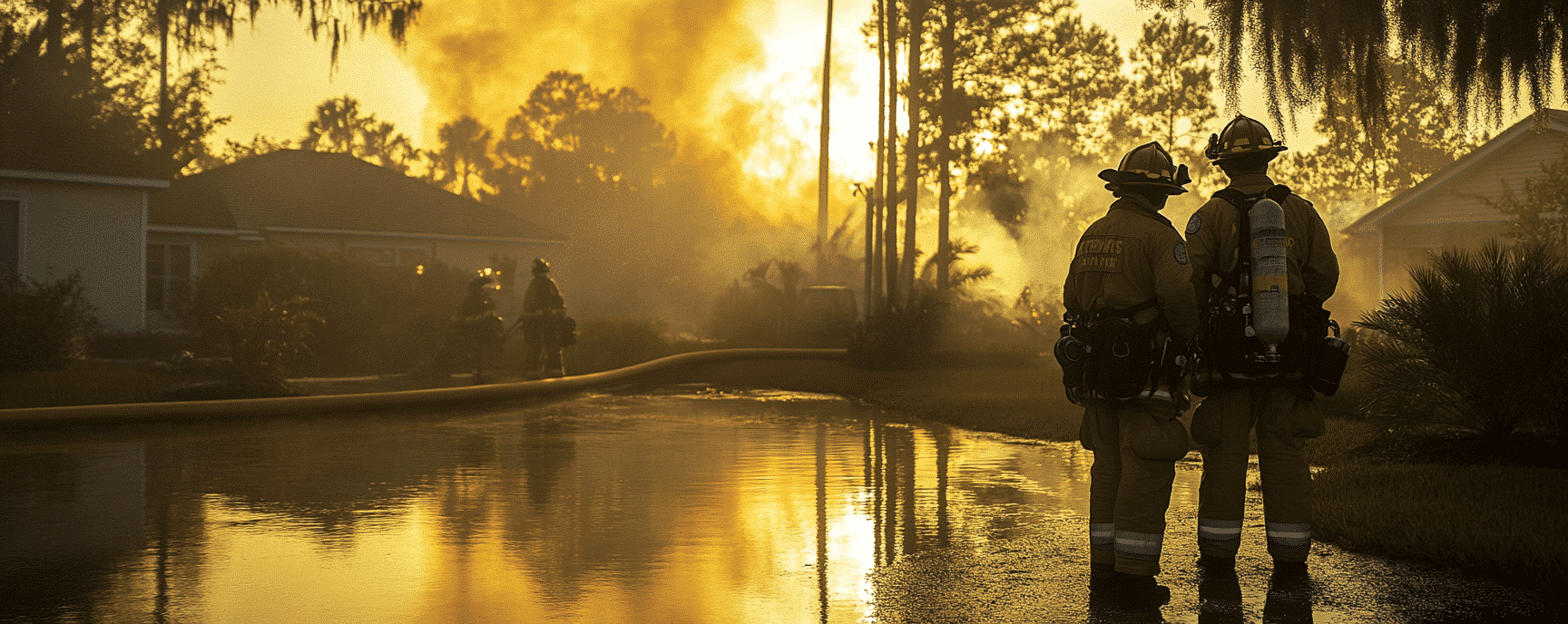Exposure to toxic firefighting foam, specifically Aqueous Film-Forming Foam (AFFF), used by firefighters, can cause health symptoms like eye irritation, skin rashes, and respiratory issues. It’s crucial to recognize these symptoms early to seek proper medical attention. This article explores both immediate and long-term AFFF exposure symptoms and health risks.
Key Takeaways
- AFFF exposure can lead to immediate symptoms like eye and skin irritation, headaches, and respiratory issues, as well as long-term health risks including various cancers and organ damage.
- PFAS, the toxic chemicals in AFFF, accumulate in the human body over time, increasing the risks of serious health issues such as cancer, thyroid disease, and liver damage.
- High-risk occupations, including firefighting and military service, are particularly susceptible to exposure to toxic firefighting foam; implementing protective measures and environmental cleanup is essential for reducing health risks.
What is AFFF and How Does it Affect Human Health?
Aqueous Film-Forming Foam (AFFF) is a specialized type of firefighting foam designed to combat flammable liquid fires. Widely used for decades, AFFF is particularly effective in creating a barrier between the fuel and the oxygen, thereby suppressing the fire. However, recent studies have uncovered that AFFF contains toxic chemicals, including per- and poly-fluoroalkyl substances (PFAS), which pose significant health risks to humans.
Definition of Aqueous Film-Forming Foam (AFFF)
AFFF is a complex mixture comprising water, fluorochemical surfactants, foam stabilizers, and other additives. Its primary function is to form a thin film on the surface of flammable liquids, effectively cutting off the fire’s oxygen supply. Despite its firefighting efficacy, the toxic chemicals present in AFFF, particularly PFAS, have been linked to a range of health problems. These include various cancers, reproductive issues, and immune system dysfunctions, making it crucial to understand the risks associated with its use.
Mechanisms by Which AFFF Harms Our Bodies
The toxic chemicals present in AFFF can enter the human body through several routes, causing significant health risks. When AFFF is deployed to extinguish fires, PFAS chemicals can become airborne, leading to inhalation by firefighters and others nearby. Additionally, these chemicals can contaminate soil and water, resulting in environmental exposure that can persist for decades.
Understanding AFFF Exposure Symptoms
AFFF exposure can lead to a variety of symptoms that may vary depending on the duration and extent of exposure. Early recognition of these symptoms allows for timely intervention, preventing further health deterioration. Neurological symptoms, such as memory loss and confusion, may occur from exposure to toxic firefighting foam, highlighting the need for awareness and proactive health measures.
Individuals in high-risk jobs, like firefighting, are particularly vulnerable to experiencing harmful health effects from AFFF exposure. These symptoms can drastically affect the quality of life, so seeking immediate medical attention after exposure to AFFF is vital.
Immediate Symptoms of AFFF Exposure
Symptoms of immediate exposure to toxic firefighting foam can extend beyond visual or physical signs. Acute symptoms include eye and skin irritation, headaches, dizziness, and respiratory issues. These symptoms can appear quickly after exposure and may require prompt medical attention to mitigate further health risks.
Exposure to AFFF can also lead to dermatological conditions, making it essential to identify and address these symptoms early on. Experiencing any immediate symptoms after AFFF exposure necessitates seeking medical advice promptly to start appropriate treatment and avoid long-term health complications.
Long-term Health Risks from AFFF Exposure
Long-term exposure to toxic firefighting foam poses significant health risks, including various types of cancer such as kidney and testicular cancer. The toxic chemicals in AFFF can overload organs like the liver, causing damage and inflammation, ultimately leading to severe health complications.
PFAS from AFFF can cause thyroid disease and alter immune system functioning, increasing the risk of immune-related health issues. Prolonged AFFF exposure correlates with higher cancer risk, liver damage, thyroid disease, and a weakened immune system, requiring ongoing health monitoring.
Toxic Chemicals in AFFF
Aqueous film-forming foam (AFFF firefighting foam) primarily contains per- and poly-fluoroalkyl substances (PFAS), which are synthetic chemicals used in toxic firefighting foam applications. These toxic chemicals pose significant health risks, including an increased likelihood of various cancers linked to PFAS contamination.
PFAS can affect the human body by damaging the lining of the colon and rectum and is often found in contaminated water, air, and soils. Comprehending the nature of these toxic chemicals helps understand the full scope of health risks associated with AFFF exposure.
How PFAS Affects the Human Body
PFAS, found in toxic firefighting foam, are notorious for their ability to accumulate in the human body over time, leading to increased health risks. They can accumulate in various organs such as the liver, kidneys, and bladder, potentially leading to organ damage or dysfunction.
PFAS exposure is also linked to hormonal imbalances and endocrine function disruptions, potentially causing reproductive health issues. Long-term PFAS exposure can lead to an increased risk of cancer, liver damage, and other serious health issues.
Routes of AFFF Exposure
Ingestion, inhalation, and skin contact are common routes of exposure to toxic firefighting foam. Inhalation of AFFF can cause respiratory symptoms like coughing and shortness of breath. Gastrointestinal symptoms such as nausea and diarrhea can also result from ingesting AFFF.
Studies have found a higher likelihood of bladder cancer in individuals exposed to AFFF, especially in regions with contaminated drinking water. AFFF use often contaminates drinking water with PFAS. This can happen in situations like fire suppression, system testing, fire training, and accidental releases. AFFF can contaminate soil and water through runoff from firefighting operations, improper disposal, and leakage from storage containers. Once in the environment, PFAS chemicals are remarkably persistent, posing long-term health risks. Exposure to contaminated soil and water can occur through skin contact, inhalation, or ingestion, making it essential to address these environmental hazards promptly. Increased cancer diagnoses have been linked to exposure to toxic firefighting foam, a firefighting agent. Prostate, pancreatic, colorectal, and other cancers are specifically associated with AFFF exposure. Chemical constituents in AFFF, especially PFAS, can potentially lead to cancerous tumors in various organs. The minimum time between first exposure to AFFF and a cancer diagnosis can range from two to 15 years, depending on the cancer type. Research indicates that individuals exposed to toxic firefighting foam have a higher incidence of bladder cancer. Various studies have observed this link. The risk of bladder cancer is particularly prevalent in communities with contaminated drinking water linked to AFFF exposure. AFFF contains toxic chemicals that accumulate in the bladder. Accumulation in the bladder can lead to cancerous cells. This emphasizes the need for vigilant health monitoring in areas affected by AFFF contamination. There is a connection between kidney cancer and exposure to toxic firefighting foam. This connection has raised concerns about AFFF’s effects. PFOA in AFFF is suspected of causing kidney cancer. A higher incidence of testicular cancer is also linked to AFFF exposure. Chemicals in AFFF can potentially disrupt hormone levels. Such disruption may affect the reproductive system and is linked to testicular cancer. Patients with higher PFOA serum levels show a greater incidence of testicular cancer. This suggests a potential link between PFOA exposure and testicular cancer. Toxic firefighting foam exposure is associated with a higher risk of liver cancer due to the toxic chemicals in AFFF. Various studies have established this connection. Research indicates a higher incidence of prostate cancer among populations exposed to AFFF. This implies a potential link between AFFF exposure and prostate cancer risk. These findings underscore the necessity for ongoing health surveillance and early detection strategies for those at risk of AFFF-related cancers. Beyond the well-documented cancer risks, AFFF exposure has been linked to various other health problems, including reproductive issues and immune system dysfunctions. These health issues can significantly impact an individual’s quality of life and have devastating effects on families. It’s important to note that the health risks associated with AFFF exposure are not confined to firefighters and military personnel. Community members living near contaminated sites are also at risk. If you have been exposed to AFFF and are experiencing symptoms or have concerns about your health, it is crucial to seek medical attention and consult with a qualified attorney to discuss your legal options.
Contact us today for your free & confidential case review. Our team will help you get the compensation that you deserve.
Some jobs come with a greater risk of exposure to toxic firefighting foam due to the specific nature and responsibilities associated with those positions. Particularly at risk are firefighters, military personnel, and airport and industrial workers. Individuals in these high-risk occupations must utilize protective measures to mitigate AFFF exposure. Recognizing these risks can advocate for better safety protocols and protective equipment. Firefighters face the highest risk of exposure to toxic firefighting foam. They experience increased exposure risks through contact with contaminated equipment and inhalation of toxic fumes. PFAS exposure for firefighters occurs through fluoropolymer-treated protective clothing and frequent AFFF use in operations. Comprehensive training on PFAS risks and AFFF handling procedures minimize exposure. Military personnel frequently use toxic firefighting foam in firefighting activities. Branches such as the Navy, Air Force, and Army have increasingly mandated AFFF use since the 1970s. Military personnel encounters AFFF exposure during firefighting emergencies and training exercises, so awareness of associated health risks and protective measures is essential. Airport and industrial workers face significant exposure risk to toxic firefighting foam due to its use in firefighting operations. Environments utilizing AFFF pose a significant risk to workers handling the substance. Recognizing the potential health risks from toxic chemicals present in AFFF is essential for implementing safety measures and reducing exposure. Reducing exposure to toxic firefighting foam is vital for preventing significant health risks associated with its toxic chemicals. Using personal protective equipment (PPE) properly can significantly limit AFFF exposure in work environments. Following environmental cleanup protocols and preventing contamination are key strategies to safeguard public health from AFFF exposure. Implementing these measures collectively minimizes AFFF exposure and protects individuals from potential health risks. Personal protective gear, such as gloves and respirators, is crucial for anyone handling toxic firefighting foam to reduce health risks. Staff should be trained on PFAS risks and safe AFFF handling procedures. Handling AFFF products requires precautions such as using gloves, masks, and full-body suits, and following proper handling and disposal procedures. AFFF spill response plans should include immediate containment, proper cleanup protocols, and decontamination. AFFF exposure poses significant environmental risks, including water source pollution and environmental degradation due to toxic firefighting foam. Washington is developing a program to collect and dispose of AFFF firefighting foam MDL, helping fire departments manage foam stock responsibly. Robust spill response plans must include immediate containment and decontamination procedures for effective AFFF spill management. Environmental cleanup and contamination prevention programs are critical for reducing AFFF exposure. Individuals seeking legal redress should first understand the available options regarding exposure to toxic firefighting foam. Individuals who develop cancer or related illnesses from AFFF exposure may file lawsuits against PFAS manufacturers for compensation. Legal recourse offers affected individuals a pathway to seek justice and compensation for health issues caused by AFFF exposure. AFFF exposure litigation can seek compensation for economic and non-economic losses, such as medical expenses and emotional suffering. Many toxic firefighting foam lawsuits are currently pending, reflecting a growing recognition of the health risks linked to AFFF exposure. Filing an AFFF firefighting foam lawsuit generally involves claiming product defects against manufacturers, without needing to prove negligence. Consulting Mausner Graham Injury Law can help assess the merits of an AFFF exposure case and potential compensation avenues. AFFF lawsuit representation is provided on a contingency basis, meaning there are no upfront fees for clients. Legal counsel is essential for navigating complexities and securing compensation for exposure to toxic firefighting foam. Consulting Mausner Graham Injury Law is essential to assess compensation eligibility based on PFAS exposure and diagnosis. Attorneys assist with evidence collection, case construction, negotiation, and court representation in PFAS-related firefighting foam cases. Individuals should consult lawyers experienced in AFFF-related cancer cases. Immediate symptoms of exposure to toxic firefighting foam include eye and skin irritation, headaches, dizziness, and respiratory issues. If you experience any of these symptoms, seek medical attention promptly. Long-term exposure to toxic firefighting foam, such as AFFF, is associated with serious health risks, including various cancers, liver damage, thyroid disease, and immune system dysfunction. It is crucial for individuals exposed to undergo continuous health monitoring. PFAS in toxic firefighting foam can accumulate in the body and result in organ damage, hormonal imbalances, and an increased risk of cancer, particularly affecting the liver, kidneys, and bladder. It’s crucial to be aware of these potential health risks. Firefighters, military personnel, and airport or industrial workers are at high risk for exposure to toxic firefighting foam. It is crucial for these professionals to implement protective measures to mitigate their risk. Victims of exposure to toxic firefighting foam can pursue lawsuits against manufacturers to seek compensation for related health issues. It’s essential to consult with legal counsel to effectively navigate the complexities of these cases. Last updated Tuesday, October 15th, 2024
Specific Cancers Linked to AFFF Exposure
Bladder Cancer
Kidney and Testicular Cancer
Liver and Prostate Cancer
Other Health Problems Related to AFFF Exposure
Reproductive Issues and Immune System Problems
 Research indicates that exposure to AFFF can disrupt hormone regulation within the human body, leading to reproductive issues such as infertility and birth defects. Additionally, AFFF exposure has been associated with immune system problems, including autoimmune diseases and chronic inflammation.
Research indicates that exposure to AFFF can disrupt hormone regulation within the human body, leading to reproductive issues such as infertility and birth defects. Additionally, AFFF exposure has been associated with immune system problems, including autoimmune diseases and chronic inflammation. High-Risk Occupations for AFFF Exposure
Firefighters
Military Personnel
Airport and Industrial Workers
Preventative Measures to Reduce AFFF Exposure
Safe Handling and Use of Protective Equipment
Environmental Cleanup and Contamination Prevention
Legal Options for AFFF Exposure Victims
Filing AFFF Lawsuits
Seeking Legal Assistance
Frequently Asked Questions
What are the immediate symptoms of AFFF exposure?
What long-term health risks are associated with AFFF exposure?
How can PFAS in AFFF affect the human body?
Which occupations are at high risk for AFFF exposure?
What legal options are available for victims of AFFF exposure?












